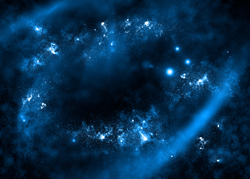Twinkle twinkle little star
Humans have always looked to the stars for knowledge and inspiration. Today they are searching the corners of space to learn about the origins of the universe and enrich their knowledge of physical laws. Of particular interest to space observatories are the star-forming regions in the universe, which can bring discoveries that take science, astronomy and physics to new heights. Using combined technologies and facilities, the 'Wide Field Studies of Star Forming Regions' (SF-WF-MSF) project is investigating the structure, evolution and dynamics of young stars. In scientific terms, the EU-funded project is studying the population of young stars in molecular clouds and embedded clusters, observing their mass, curiosities and effect of currents from massive stars. The project is taking advantage of next generation sky surveys to observe star-forming regions. When combined with the power of NASA's Spitzer Space Telescope, these surveys and subsequent observations can observe molecular clouds to a very precise degree. The project members can then study star formation in novel ways and test theories of star formation. They will examine the mechanism behind the formation of massive stars and their early influence on the evolution of the star formation process within molecular clouds. The project member organisations, which hail from the EU and India, have pursued several aspects of the above research. The magnitude of available and future data is enormous, and efficient exploitation of such data for scientific investigation requires multiple groups working on various angles of the science. Through this proposal the project is combining the expertise and efforts of three groups to obtain maximum output from the wide-field surveys of star-forming regions. The project has revealed some very important scientific findings. It has mapped the sequence of low and high-mass star formation in a young spatial cluster located in the Galactic mid-plane. The results indicate that low-mass stars form prior to massive stars in a cluster-forming environment. The study has also shed new light on why some surveys are not effective in uncovering the clusters around massive protostars situated in the Galactic mid-plane. SF-WF-MSF has also ascertained that a certain star cluster, known as W40, is next in importance to the Great Orion Nebula itself. It represents a new laboratory for understanding star formation in embedded clusters and adds to knowledge about space and physics. Many more important results are set to emerge from this project, promising to yield new ways of understanding the universe – an exciting premise for scientists and academics in the field.



